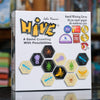
The Strategic Depths of Hive: A Board Game for the Mind
, by Jack Jones, 5 min reading time

, by Jack Jones, 5 min reading time
In the panorama of board games, where the landscape is dominated by games dating back centuries like chess, and ones with mass cultural penetration like Scrabble, "Hive" carves out a distinct niche. Introduced to the world by John Yianni in 2001, Hive has since emerged as a modern classic. It is a game that speaks to strategy enthusiasts and casual gamers alike, with its blend of straightforward rules and deep strategic play.
Hive is often likened to chess for a reason. It's a two-player game that involves no game board, with the action instead taking place on any flat surface. The goal is simple: surround your opponent's queen bee while protecting your own. The game ends immediately once a queen bee is fully encircled by pieces from either player.
What sets Hive apart is its continuously changing landscape. Each piece is hexagonal, and as players add pieces, the 'board' grows. Movement is constrained by the need to keep the hive (the collection of pieces) connected, and each insect's type dictates its movement, echoing the varying powers of chess pieces but with an entomological twist.
Each player starts with eleven hexagonally shaped pieces, one queen bee, two spiders, two beetles, three grasshoppers, and three soldier ants, all ready to be deployed. The game's tension comes from deciding when to add pieces to the game and when to move them.
- The Queen Bee has power but limited mobility, moving only one space at a time.
- Beetles climb over other pieces, changing the topography of the game.
- Spiders move precisely three spaces no more, no less.
- Grasshoppers leap over rows of pieces in a straight line.
- Soldier Ants boast extensive range, encircling enemy bugs with ease.
This array of movements makes each game unfold in an unpredictable way, with players reacting not just to their opponent's last move, but to the evolving shape of the hive itself.
One of the most alluring aspects of Hive is that there's no element of luck. There are no dice rolls or card draws; the game's outcome is purely determined by player decision-making. This aspect appeals to those who love pure strategy.
The opening moves in Hive are crucial. Just as in chess, an opening can set the tone for the entire game. A poor initial strategy in Hive can lead to a quick defeat, as your opponent can capitalize on early mistakes. The game requires not only tactical deftness but also foresight into the game's future state, much like a grandmaster anticipates moves in chess.
While Hive is deeply strategic, it is also wonderfully social. Games typically last 20 minutes, meaning it can be played and replayed in one sitting, encouraging conversation and connection between rounds. It's a game that doesn't demand linguistic or cultural prerequisites, making it universally accessible and an excellent vehicle for interaction across barriers.
The pieces are robust, typically made from bakelite, and are satisfying to handle, etched with the insects they represent. Hive doesn't require a board and can be played on any surface, indoors or out, making it uniquely portable among strategy games. This durability and portability add a practical allure to the game.
Hive has grown beyond a mere pastime into the competitive arena, with a dedicated and growing community. There are annual championships and a plethora of online resources dedicated to Hive strategy, reflecting its complexity and the dedication of its player base.
Hive teaches adaptation. Because there's no resetting the board, each game evolves differently, and successful players must adapt their strategies in real time, responding to their opponent's maneuvers while considering the broader state of play. It fosters a mindset that is as much about resilience and flexibility as it is about pre-planned strategy.
For younger players, Hive can be a learning tool. It encourages spatial reasoning, planning, and problem-solving. By engaging with the game, players, especially children, can develop cognitive skills related to mathematics and logic.
Despite its relatively recent introduction to the world of board games, Hive has already left a significant cultural footprint. The game's unique combination of strategy and simplicity has inspired digital versions, expanded with several expansions, including The Mosquito, The Ladybug, and The Pillbug, each adding new dimensions and strategies to the core game.
As Hive continues to grow in popularity, it also evolves with its community. There are variant rules and fan-created expansions that add layers of complexity or novelty. With its simple concept and limitless strategic depth, Hive is a game that seems poised to endure, offering fresh challenges with each play and cementing its place in the canon of classic strategy games.
Hive, with its perfect marriage of simplicity and depth, is more than just a game; it's a medium through which players engage in silent dialogue punctuated by the clack of pieces moving across an ever-changing board. It's chess for the insect kingdom, a battle of wits, and a dance of strategy and foresight. Whether at a park, a beach, or over coffee, Hive invites you to challenge your mind, one move at a time.